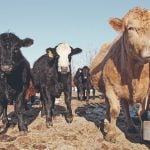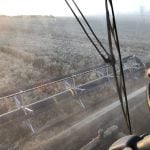On a stage with the lights dimmed, Brenna Grant sits with several other industry professionals, looking out on a room full of people. From all over the country, they’ve met in Penticton, B.C., to discuss the future of their industry at the Canadian Beef Industry Conference.
One of those possible futures is encompassed in the 2030 Canadian Beef Goals.
The 2030 goals comprise a series of 10 goals in a variety of sectors, such as technology advancement, carbon, animal welfare, human welfare, land use and beef quality. Several organizations in the industry are involved with these goals, including the Canadian Roundtable for Sustainable Beef, the Canadian Cattle Association, the Beef Cattle Research Council, the Canadian Beef Council, the Canadian Beef Breeds Council, Canada Beef and Canada’s National Beef Strategy.
Read Also

The Canadian Cattle Association’s international advocacy efforts
Global ag policies affect Canadian food policy, so the Canadian Cattle Association participates in international and domestic forums
Brenna Grant, executive director at Canfax, is spearheading the process for the carbon goals, which aim to reduce greenhouse gas emissions from primary production by 33 per cent and increase carbon sequestration by 3.4 million tons per year.
Carbon sequestration
In Canada, grasslands stretch from Manitoba to Alberta. Twenty-five per cent of Canada’s native grasslands remain. These grasslands sequester large amounts of carbon underground, so there is no risk of the carbon being released, unlike in forests, where fires cause damaged trees to release carbon.
[RELATED] Grazing can AMP up carbon sequestration, U of A researcher says
Through studies, researchers are finding different ways to increase the amount of carbon grasslands sequester.
“In terms of carbon sequestration, we’re really in the research and data collection (stage) and making sure that we’re filling all the research gaps,” Grant says.
Research projects funded by Beef Cattle Research Council have been looking at different types of soils, zones, vegetation and grazing management practices. Grant says this will all benefit how they move forward with this specific 2030 goal.
“So that we’ll have a better understanding of carbon sequestration, how it works and what our current rates are,” Grant says.
An example of this kind of research is adaptive multi-paddock (AMP) grazing, which researchers at the University of Alberta have been looking into. They have found that AMP grazing increases the carbon sequestration of grasslands.
Two years into these 2030 goals, Grant says there are many things to look forward to when it comes to carbon sequestration. She says they’ve had meetings with the industry.
“I think on the carbon sequestration side, it’s the fact that we are engaging in conversations with governments about how to actually get these things recognized within the national inventory reports because that’s where government then says, ‘Okay, the beef industry has actually achieved this.’”
Cutting greenhouse gases
Grant says the Canadian Beef advisors created the 2030 goals in 2020 to set goals that they wouldn’t have previously met without it, while also keeping the producer in mind.
“We also wanted (the goals) to be realistic for producers in terms of the biological limits of the animal,” Grant says.
[RELATED] Global Roundtable for Sustainable Beef launches carbon footprint guideline for emissions reporting
The group working on the carbon goals considered many things before choosing 33 per cent as their decrease goal.
“We asked ourselves, ‘Okay, what if we were able to continue on trend with incremental improvement in research and adoption rates and technology?’” Grant explains. “And then we said, ‘Okay, what if we had a major breakthrough of being able to increase adoption levels of practices that reduce greenhouse gas emissions, increase carbon sequestration? Or maybe if there was a new technology that came in the markets? What would that potentially look like?’”
Grant says that if the industry continues the way that it has been on the historical trend with slight improvements, that would give the industry a 17 per cent reduction in emissions. Now, the industry must take steps to turn that 17 per cent into 33. Grant says they have a multifaceted plan to get there.
“We’re looking at what our adoption rates of practices that we know reduce greenhouse gas emissions that are shown by research to do that and asking producers to consider it … some of those things are inclusion of legumes, extending the grazing season to reduce feeding days, keeping cattle on pasture versus in confinement during the winter, precision feeding and production-enhancing technologies.”
But to reach 33 per cent in decreased emissions, Grant says more research has to be done and they will need a breakthrough in technology. An example she cites is 3-NOP.
Ongoing researchand 3-NOP
Dr. Kim Ominski is a professor and acting head of the department of animal science at the University of Manitoba and a researcher involved with the 2030 Canadian Beef Goals. She got involved with the research for these goals along with colleagues from across Canada.
“There’s tremendous collaboration amongst scientists, representing the Canadian perspective and the Canadian landscape,” Ominski says.
Grant says there’s a variety of different types of work being done on the research side to make progress towards the 2030 goals. Ominski echoes that statement, saying that not only are many different researchers working on the project, but they are also working with different companies and organizations, such as Agriculture Canada and Farmers For Climate Change, on many different topics.
Some of these topics include improving forage quality by including a legume in the diet or harvesting earlier; strategies to include byproducts and food waste in the cattle industry; and management practices, to name a few.
“Some of these fundamental things we’ve been doing all along,” Ominski says. “But certainly now being able to not only explore where the opportunities are but being able to quantify those from an environmental perspective.”
3-NOP, also known as 3-nitrooxypropanol, is a methane-inhibiting compound that can be used as a feed additive in cattle. The compound was created by the Dutch company DSM Nutritional Products. Though it was approved in the European Union in February, it has not been approved in Canada.
Dr. Karen Beauchemin says they have run tests on 3-NOP in Canada.
“The scientific community has found that it depends on the dose to some extent and the type of diet and the type of cattle,” Beauchemin explains. “So the reduction in methane is anywhere from about 20 per cent and in feedlot finishing diets, we’ve had even up to 80 per cent. So it really does depend on the diet. Higher concentrate diets, it’s easier to suppress methane. Higher roughage, lower-quality diets, then the reduction will be less.”
[AUDIO] Karen Beauchemin explains what 3-NOP is and how it works.
Beauchemin explains that in Canada, any additive you feed cattle that is manufactured is classified as either a feed or a drug. A drug is considered anything that changes the animal’s metabolism, so 3-NOP is considered a drug.
Currently, Beauchemin doesn’t know when the additive might get approval in the country, but it likely won’t be within the next three years.
She says given how much 3-NOP could reduce methane emissions, it could help the environment as well as the beef industry, which has been under fire for the methane emissions cattle produce. However, she’s not sure if it appeals to the producers themselves.
“Our Canadian producers don’t really get paid to reduce methane emissions directly.
“If there’s no financial benefit to the producers, then it gets a little dicey. But on the other hand … I know the Canadian government is developing a carbon offset program, which would allow producers to participate.”
Another thing she mentioned is that although there has been research done on the additive in Canada, it’s only been tested on dairy cattle or in commercial feedlots — not on cow-calf operations where cattle graze in pastures for part of the year.
“There’s been very little work done with grazing animals,” she says.
Carbon offset program
At the Canadian Beef Industry Conference, Adam Shreck, a production consultant for Telus Agriculture Feedlot Health, spoke to conference-goers about carbon credit opportunities in the beef sector.
He explained that there are currently two types of offset programs that exist in North America — and Alberta is an important factor.
“Alberta is kind of a leader in developing carbon offset pricing schemes, not just in the feedlot world and the cow world, but in the oil and gas world,” Shreck says.
Alberta has been a leader in this since the 2000s. According to the Alberta government website, “Emission offsets are generated by projects that have voluntarily reduced their greenhouse gas emissions.”
According to the government of Canada, over 20 million metric tonnes of carbon dioxide emissions have been reduced because of this offset program in Alberta.
“Now remember that this only is in Alberta,” Shreck says. “This is nowhere else in Canada and nowhere else in the world. There are several that are considering adopting the quantification protocols that have been established in Alberta elsewhere.”
The other offset program that, according to Shreck, is more common in the U.S. but could be seen in Canada is called a voluntary market. According to Climate Focus, this is “a decentralized market where private actors voluntarily buy and sell carbon credits that represent certified removals or reductions of greenhouse gases (GHGs) in the atmosphere.”
Onwards and upwards
Grant says the Canadian Beef Advisors will continue monitoring the 2030 goals.
“This goal has a working group that’s identifying all of the key milestones and things that need to be done,” Grant says. “So that we’re continually monitoring that and evaluating, how are we going to get there to that 2030 goal?”
She says it’s important for producers to know that although the industry has these goals, they’re not going to ask producers to change their way of life.
“I think the biggest thing is we’re not asking them to do anything that would not be economically beneficial for them. We want them to consider these practices and to use a sharp pencil and to see if there’s anything they can incorporate in their operation, in their environment, that makes economic sense.”

















